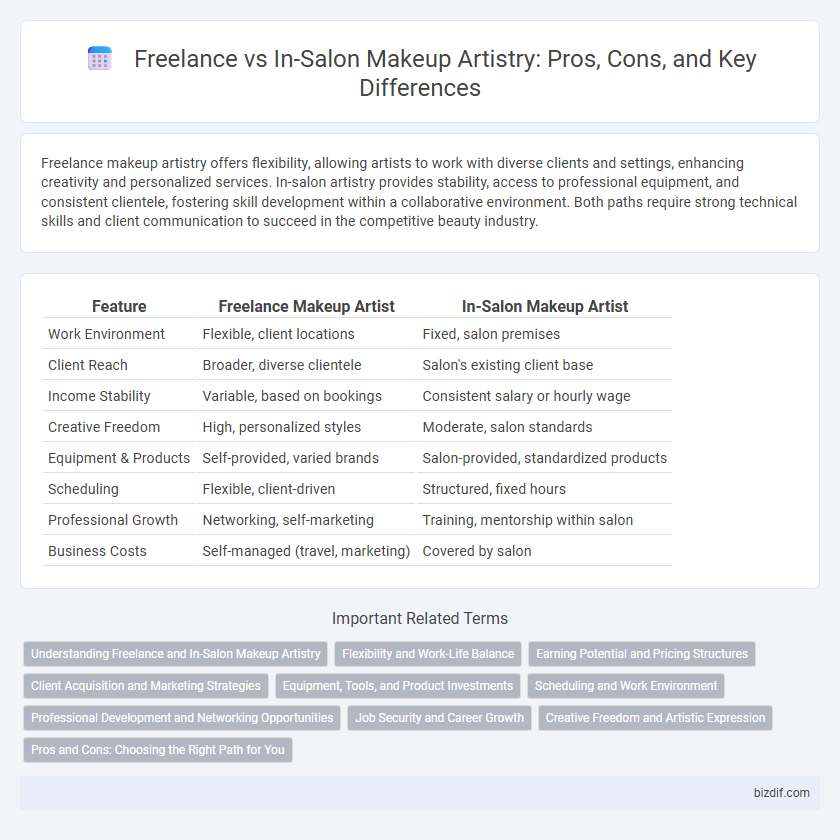Freelance makeup artistry offers flexibility, allowing artists to work with diverse clients and settings, enhancing creativity and personalized services. In-salon artistry provides stability, access to professional equipment, and consistent clientele, fostering skill development within a collaborative environment. Both paths require strong technical skills and client communication to succeed in the competitive beauty industry.
Table of Comparison
| Feature | Freelance Makeup Artist | In-Salon Makeup Artist |
|---|---|---|
| Work Environment | Flexible, client locations | Fixed, salon premises |
| Client Reach | Broader, diverse clientele | Salon's existing client base |
| Income Stability | Variable, based on bookings | Consistent salary or hourly wage |
| Creative Freedom | High, personalized styles | Moderate, salon standards |
| Equipment & Products | Self-provided, varied brands | Salon-provided, standardized products |
| Scheduling | Flexible, client-driven | Structured, fixed hours |
| Professional Growth | Networking, self-marketing | Training, mentorship within salon |
| Business Costs | Self-managed (travel, marketing) | Covered by salon |
Understanding Freelance and In-Salon Makeup Artistry
Freelance makeup artistry offers flexible scheduling and the opportunity to work with diverse clients and projects, enhancing creative growth and personal brand development. In-salon makeup artists benefit from a stable income, access to professional-grade products, and a consistent client base, fostering skill refinement within a structured environment. Understanding these dynamics helps artists choose paths aligned with their career goals and lifestyle preferences.
Flexibility and Work-Life Balance
Freelance makeup artists enjoy greater flexibility in scheduling, allowing them to choose clients and projects that fit their personal routines, which often leads to improved work-life balance. In-salon artists typically have fixed hours and client appointments, resulting in a more structured but less adaptable work schedule. This contrast makes freelancing ideal for those prioritizing autonomy and varied workloads, while in-salon artistry suits professionals who prefer consistent hours and a stable environment.
Earning Potential and Pricing Structures
Freelance makeup artists often command higher rates due to the flexibility and personalized services they offer, allowing them to set variable pricing based on client demand, event type, and location. In-salon makeup artists usually have fixed pricing structures dictated by the salon, with less opportunity for markup or premium charges, resulting in more consistent but often lower earnings. The earning potential for freelancers can exceed that of in-salon artists when they successfully leverage niche markets and build a strong client base through social media and portfolio diversity.
Client Acquisition and Marketing Strategies
Freelance makeup artists rely heavily on social media platforms, personal branding, and networking events to attract and retain clients, leveraging digital portfolios and influencer collaborations for wider reach. In-salon artists benefit from built-in client flow through salon walk-ins and loyalty programs, often utilizing the salon's established reputation and referral systems for steady business growth. Both approaches require targeted marketing strategies, but freelancers must prioritize online presence and client relationship management more aggressively to compete in diverse markets.
Equipment, Tools, and Product Investments
Freelance makeup artists invest heavily in portable, versatile equipment, including high-quality brushes, compact palettes, and travel-friendly lighting to ensure professional results on the go. In-salon artists typically rely on comprehensive, permanent setups with access to a wider range of specialized products, professional-grade tools, and salon-grade skincare lines. Both models require strategic allocation of budget toward durable products, but freelancers prioritize multi-use and lightweight equipment for mobility, while salon artists benefit from shared resources and bulk inventory.
Scheduling and Work Environment
Freelance makeup artists enjoy flexible scheduling, allowing them to choose clients and optimize work hours, while in-salon artists often adhere to fixed shifts and appointment slots. The freelance environment offers diverse locations and client settings, fostering creativity and independence, whereas salon artistry provides a structured workplace with access to professional tools and collaborative support. Scheduling autonomy in freelancing contrasts with the predictable routine of salon jobs, influencing work-life balance and career growth opportunities.
Professional Development and Networking Opportunities
Freelance makeup artists often experience accelerated professional development through diverse client interactions and varied project types, fostering adaptability and skill expansion. In-salon artists benefit from structured training programs and consistent mentorship, which enhance technical expertise and client management skills. Networking opportunities for freelancers primarily come from industry events and social media platforms, while in-salon artists gain connections through daily client interactions and salon collaborations.
Job Security and Career Growth
Freelance makeup artists enjoy flexibility and diverse client exposure but face inconsistent job security due to fluctuating demand and self-managed marketing. In-salon makeup artists benefit from stable employment with steady income, training opportunities, and potential for career advancement within established beauty brands. Career growth in freelancing depends heavily on personal branding and networking, while in-salon professionals often have structured paths for promotions and skill development.
Creative Freedom and Artistic Expression
Freelance makeup artists enjoy greater creative freedom, allowing them to experiment with diverse styles and tailor their work to a wide range of clients and projects. In-salon artists often follow standardized techniques and brand guidelines, which can limit their scope for artistic expression. The flexibility of freelance artistry fosters innovation and personal growth, whereas in-salon roles provide consistency and structured skill development.
Pros and Cons: Choosing the Right Path for You
Freelance makeup artistry offers flexibility, diverse client opportunities, and creative freedom but often comes with inconsistent income and the responsibility of self-promotion and business management. In-salon artistry provides a steady paycheck, access to professional resources, and a built-in client base but may limit creative control and require adherence to salon policies and schedules. Weighing stability against autonomy is crucial for makeup artists when deciding between freelance or in-salon career paths.
Freelance artistry vs In-salon artistry Infographic

 bizdif.com
bizdif.com